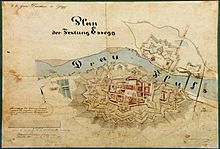






This article contains too many pictures for its overall length. |
| Part of a series on |
| War (outline) |
|---|
 |
A bastion fort or trace italienne (a phrase derived from non-standard French, literally meaning 'Italian outline') is a fortification in a style that evolved during the early modern period of gunpowder when the cannon came to dominate the battlefield. It was first seen in the mid-fifteenth century in Italy. Some types, especially when combined with ravelins and other outworks, resembled the related star fort of the same era.
The design of the fort is normally a polygon with bastions at the corners of the walls. These outcroppings eliminated protected blind spots, called "dead zones", and allowed fire along the curtain wall from positions protected from direct fire. Many bastion forts also feature cavaliers, which are raised secondary structures based entirely inside the primary structure.
- ^ From Cyclopaedia
- ^ Centre, UNESCO World Heritage. "The city of Bergamo - UNESCO World Heritage Centre". whc.unesco.org. Retrieved 2 November 2017.